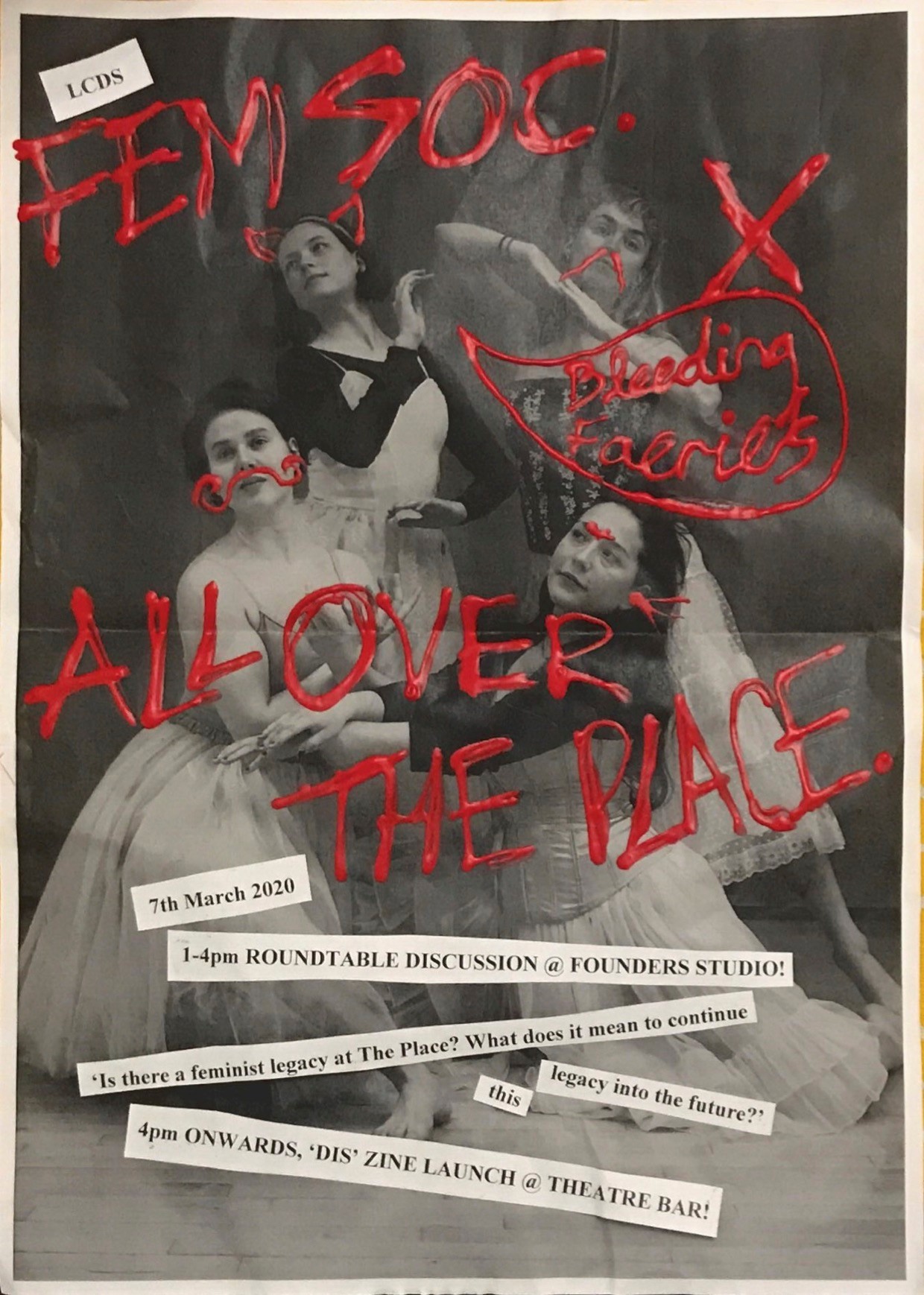BLEEDING FAERIES ALL OVER THE PLACE
Roundtable and Zine Launch Party7th MARCH 2020
CREDITS
FEMSOC curators: Tasha Hess-Neustadt, Anouk Jouanne, Venla Niitemaa, Rebecca Douglass, Kitty Pilgrim-Morris, Marta Hlín Þorsteinsdóttir, Théïa Maldoom
Panelists: Sue MacLennan, Sasha Roubicek, Lauren Potter, Grace Nicol, Alethia Antonia, Iro Costello, and Elisabeth Schilling.
(with contributions from Eva Recacha via text and Alexandrina Hemsley via audio)
Live music: JENNY ALIEN
Art Installation and photography: Théïa Maldoom
Facilatator and Poster Design: Rebecca Douglass
An intergenerational roundtable discussion with an array of dance and performance artists, discussing the idea of the Feminist Legacy in and surrounding The Place, and what it might mean to continue this legacy into the future.
The roundtable was followed by the launch of the latest edition of DIS, a feminist Zine originally founded by Orrow Bell and passed on to the Feminist Society for continuation.
The poster was designed in reference to the original 'Bleeding Fairies' image which was the front cover of New Dance Magazine (Issue 5 1978), as well as the 1977 performance of the same name by X6 members Jacky Lansley, Emylin Claid, and Mary Prestidge.
X6 were an experimental dance collective founded by Fergus Early, Jacky Lansley, Emylin Claid, Madee Dupres and Mary Prestidge.’The infamous image on the front cover of New Dance Magazine was of a romantic ballerina with the words 'bleeding fairies' emerging from her sweetly smiling mouth (Issue 5 1978). On the back cover was an image of a classical ballerina wearing a white tutu, her leg high in arabesque, with blood scribbled onto her crotch with a red pen. These crude images have been used as the publicity material for the performance Bleeding Fairies (1977)' (Yes? No! Maybe...: Seductive Ambiguity in Dance By Emilyn Claid page 63).
X6 were one of the first groups to have their own space, cultivating choreography, classes, discussions and a magazine (New Dance Magazine) exploring often highly political content. They left behind a legacy of dance/dancers being so much more than just performance/performers; they were feminists, non-conformists, educators, artists and a body of diversity.
The roundtable was followed by the launch of the latest edition of DIS, a feminist Zine originally founded by Orrow Bell and passed on to the Feminist Society for continuation.
The poster was designed in reference to the original 'Bleeding Fairies' image which was the front cover of New Dance Magazine (Issue 5 1978), as well as the 1977 performance of the same name by X6 members Jacky Lansley, Emylin Claid, and Mary Prestidge.
X6 were an experimental dance collective founded by Fergus Early, Jacky Lansley, Emylin Claid, Madee Dupres and Mary Prestidge.’The infamous image on the front cover of New Dance Magazine was of a romantic ballerina with the words 'bleeding fairies' emerging from her sweetly smiling mouth (Issue 5 1978). On the back cover was an image of a classical ballerina wearing a white tutu, her leg high in arabesque, with blood scribbled onto her crotch with a red pen. These crude images have been used as the publicity material for the performance Bleeding Fairies (1977)' (Yes? No! Maybe...: Seductive Ambiguity in Dance By Emilyn Claid page 63).
X6 were one of the first groups to have their own space, cultivating choreography, classes, discussions and a magazine (New Dance Magazine) exploring often highly political content. They left behind a legacy of dance/dancers being so much more than just performance/performers; they were feminists, non-conformists, educators, artists and a body of diversity.
